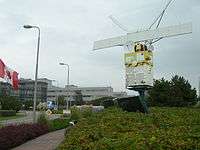Mission Science Division
| Acronym | ESA |
|---|---|
| Website |
www |
The Mission Science Division is a group of ESA mission scientists, research fellows, young graduates, and administrative staff working at the European Space Agency (ESA) within the Science, Applications and Future Technologies Department of the Directorate of Earth Observation Programmes. The Division is located at ESA's European Space Research and Technology Centre in Noordwijk, South Holland, The Netherlands.
Introduction
The Mission Science Division (MSD) supports the preparation, development and operations of scientific research and operational missions within the Earth Observation Programmes Directorate. The Division is responsible for ensuring the application of scientific and other user community requirements in all phases of the development of Earth Observation missions, from precursor studies through to in-orbit satellite operations, and for ensuring coherence throughout with the objectives expressed in the mission requirements documents, including the management of mission-, instrument-specific, or ad-hoc advisory structures (as required).
In support of the preparation of new mission concepts, or development and operations of each ESA approved Earth Observation mission, the Division conceives, initiates and conducts supporting scientific studies (in house and external) to ensure that the mission is "fit for purpose". In addition, the Division organises, coordinates and executes Campaigns for the purpose of acquiring airborne, balloon-borne, or in-situ data. Campaigns are specifically designed in support of technology or mission concept development, mission development, data simulation, and instrument calibration or product validation purposes. Campaign data are distributed publicly.
|
ESTEC in Noordwijk, Netherlands | |
| Abbreviation | ESTEC |
|---|---|
| Location | |
Parent organization | European Space Agency |
| Website |
www |
Mission Science Division Management
The Mission Science Division management team are:
- M. Drinkwater (Head of Mission Science Division)
- P. Ingmann (Head of Atmospheric Section)
- R. Haagmans (Head of Earth Surfaces and Interior Section)
- M. Davidson (Head of Campaigns Section)
Earth Explorer – Research Missions
The Mission Science Division has prepared and contributed to the approval of eight ESA Earth Explorers , with two new mission candidates to be selected from proposals resulting from a 2015 call for the ninth Earth Explorer mission, namely:
Earth Explorer Core missions
- GOCE (launched successfully on 17 March 2009; successfully completed its mission on 13 November 2013).
- ADM-Aeolus
- EarthCARE
- Biomass
Earth Explorer Opportunity missions
- CryoSat-2 (launched successfully on 8 April 2010)
- SMOS launched successfully on 2 November 2009)
- Swarm (launched successfully on 22 November 2013)
- FLEX -Fluorescence Explorer (*selected in November 2015)
A Call for proposals for new Earth Explorer missions was released in November 2015 .
Earth Watch Missions
The Division currently supports the development of seven series of approved Copernicus Programme Sentinel Missions as part of the Space Component of the joint EC/ESA Copernicus initiative. It has supported the development of MetOp, and is currently active in supporting the preparation of MetOp Second Generation.
Copernicus Space Component missions
- Sentinel 1 – (Sentinel-1A launched successfully on 3 April 2014)
- Sentinel 2 – (Sentinel-2A launched successfully on 23 June 2015)
- Sentinel 3 – (Sentinel-3A launched successfully on 16 February 2016)
- Sentinel 4 (on Meteosat Third Generation-S)
- Sentinel 5 precursor
- Sentinel 5 (on MetOp-Second Generation- Metop-SG)
- Sentinel 6 – (also known as Jason Continuity of Service – Jason-CS)
Operational Meteorological Satellite Series
The Division also presently supports the development of several instruments out of the 10 instrument payload of the approved series of second generation MetOp satellites. The MetOp-SG series is developed in cooperation with EUMETSAT, as part of the EUMETSAT Polar System – Second Generation initiative. EPS-SG represents Europe's contribution to the future Joint Polar System (JPS).
- MWS (MicroWave Sounder), to provide atmospheric temperature and humidity profiles
- SCA (Scatterometer), to provide ocean surface wind vectors and land surface soil moisture
- RO (Radio Occultation sounder), to provide atmospheric temperature and humidity profiles, as well as information about the ionosphere
- MWI (MicroWave Imager), to provide precipitation monitoring as well as sea ice extent information
- ICI (Ice and Cloud Imager), to measure cloud ice water path, properties and altitude
- 3MI (Multi-viewing, Multi-channel, Multi-polarisation Imager), to provide information on atmospheric aerosols
- UVNS/S5 (Ultra-Violet /Visible/Near Infrared/Short Wave Infrared spectrometer -Sentinel-5) instrument, to monitor various trace gases, air quality and support climate monitoring
External links
For more information, see
- Official website of the European Space Agency (ESA)
- Webpage of the Living Planet Programme of the European Space Agency
- Webpage of the Earth Explorer Missions
- Campaigns page of the Mission Science Division
- Campaigns Blog
